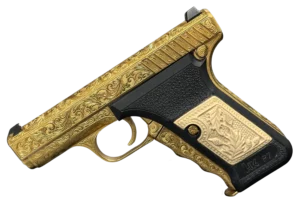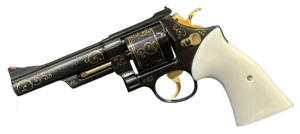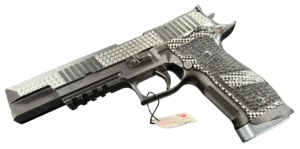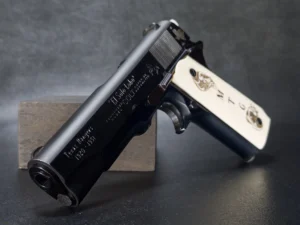Key Takeaways:
- The Steyr-Hahn wasn’t just another pistol—it was a mechanical leap forward: Born in 1912, it marked a pivotal shift from revolvers to reliable semi-automatic sidearms. Built with Austrian precision and loaded via a quirky-but-effective stripper clip system, the Steyr-Hahn redefined what soldiers expected from a sidearm in the trenches of World War I.
- Soldiers didn’t just carry it—they counted on it: This wasn’t a gun that jammed or choked in bad weather. It was trusted. In brutal conditions—from alpine frost to desert dust—the Steyr-Hahn earned its place as more than gear. It was a steel companion that offered both firepower and peace of mind.
- Today, it’s a living artifact of a lost world: Collectors and historians prize the Steyr-Hahn not just for its rarity, but for its story. It’s a relic that still sparks curiosity and admiration—a link between past and present, crafted in an age when firearms were built to endure, not just function.
Let’s take a moment to appreciate something often overlooked in the rush of military history—a pistol that, for its time, didn’t just do its job. It did it with style, reliability, and a mechanical confidence that echoed through two world wars. Meet the Steyr-Hahn: a semi-automatic handgun that was as much a product of old-world craftsmanship as it was a preview of things to come.
Now, maybe you’ve seen one in a museum or tucked away in a collector’s case. But the real story of the Steyr-Hahn isn’t just in its specs. It’s in the mud, the trenches, the backrooms of history where innovation quietly changed everything.
From Austria With Grit: The Birth of the Steyr-Hahn
It all kicked off in 1912. The world wasn’t quite at war, but you could feel the tension crackling in the air. Austria-Hungary, perched on a geopolitical powder keg, needed a sidearm that could keep up. Enter the Steyr-Hahn—a name that sounds like a mechanical waltz, and fittingly so. “Steyr” for the city, “Hahn” for the hammer. Simple, solid, no fluff.
And that’s exactly what the pistol was: a steel promise of reliability at a time when the world was spinning fast toward chaos. You had nations modernizing, armies mobilizing, and a wave of new firearm designs crashing into military inventories. The Steyr-Hahn stood out—not flashy, but smart. Built like a tank, yet elegant enough to suggest that someone really cared about the little details.
Its sleek silhouette wasn’t just for show, either. It housed a semi-automatic system that made revolvers look like relics overnight. In short, this was a pistol ready for the next big thing—even if no one quite knew what that was yet.
Built Like a Clock, Shoots Like a Dream
Mechanically, the Steyr-Hahn was something else. The action was crisp, the recoil manageable, and every part seemed to just click into place. This was no slapped-together war tool—it was Austrian engineering at its best. You could say it was the firearm equivalent of a fine mechanical watch: reliable, precise, and surprisingly satisfying to operate.
Let’s talk ammo for a second. The pistol fired the proprietary 9mm Steyr cartridge, which had some serious punch for the era. Combine that with the unique stripper clip loading system—yes, stripper clips on a pistol—and you’ve got a reload process that looked odd but worked well under pressure. Soldiers got used to it quickly. When things got loud and messy, being able to reload without fumbling was no small advantage.
Comfort matters, too, especially when you’re carrying the thing day in and day out. The grip wasn’t just an afterthought. It felt natural, gave solid control, and made accurate follow-up shots far easier than you’d expect for something over a century old.
War-Tested, Soldier-Approved
When World War I broke out, the Steyr-Hahn wasn’t just another item on the inventory list—it was a lifeline. In a world of bolt-action rifles and slow reloads, having a semi-auto sidearm like this could mean the difference between living to see another day or not.
It saw action in the trenches, on mountain ridges, in dusty corners of the empire where no maps could quite agree on the borders. And here’s the thing—it didn’t care where you took it. It just worked. Cold, heat, dirt, snow—Steyr-Hahn didn’t flinch.
There’s a kind of comfort in knowing your gear won’t let you down. Soldiers trusted this pistol not just because of what it could do, but because of what it didn’t do. It didn’t jam. It didn’t misfire. It didn’t fall apart. That kind of dependability? That’s not just useful—it’s morale-boosting, especially in the bleak, sanity-challenging moments of trench warfare.
And it wasn’t just about hardware. The look of the Steyr-Hahn—the hammer, the contours, the confidence it exuded—left a psychological impression, too. It became something more than just a tool. It was a quiet reminder that someone back home had thought ahead, prepared well, and sent you into battle with something built to last.
Influence That Outlived the Empire
The Austro-Hungarian Empire is long gone, but the Steyr-Hahn? Its fingerprints are still all over modern firearms. Not directly, perhaps—you won’t see too many new pistols using stripper clips these days—but conceptually, it left a mark.
It helped shape what we expect from a sidearm: fast, dependable, reasonably powerful, and ergonomic enough to stay relevant across generations. That shift in thinking—from revolver-centric to semi-automatic dominance—was partly thanks to this unassuming Austrian machine.
And military brass took notes. After the war, everyone started to see handguns not as backup weapons, but as tactical necessities. Compact firepower you could rely on in a pinch. The Steyr-Hahn didn’t just survive the war; it helped reframe how wars would be fought.
More Than Metal: The Collector’s Perspective
Fast forward a hundred years, and the Steyr-Hahn is no longer riding into battle. But it hasn’t vanished—it’s just found a new home among collectors, curators, and history buffs who see it for what it is: a mechanical time capsule.
Each pistol tells a story. Some bear regimental markings, others scars from service. A few may have never left the armory. But every Steyr-Hahn has something to say about where it came from, who carried it, and what it lived through.
Collectors prize them not just for rarity, but for what they represent. They’re snapshots of a vanished world, frozen in steel. And they’re unusually fun to shoot, even by modern standards.
You’ll also find them in museums, not just behind glass but in conversations. People want to know how it worked, why it mattered, and what made it different. In a world of plastic frames and modular parts, the Steyr-Hahn feels like a whisper from a time when metal met purpose with no shortcuts taken.
A Legacy That Refuses to Rust
The Steyr-Hahn isn’t a flashy firearm. It doesn’t have the Hollywood fame of the Luger or the iconic silhouette of the Colt 1911. But you know what? That’s part of its charm. It earned its place in history not by showboating, but by doing the work, day in, day out, under fire.
Its design still speaks to us, not just as a product of its time but as a lesson in what happens when function and form align just right. And in an age where disposable tech dominates, there’s something comforting about holding a tool that was built to last.
So, the next time you see one—maybe in a collection, maybe on display—don’t just walk by. Stop. Listen. Because if you pay attention, the Steyr-Hahn still has a few stories left to tell.
Frequently Asked Questions
It’s a semi-automatic pistol developed in Austria in 1912, officially called the M1912. “Steyr” refers to the city where it was built, and “Hahn” is the German word for hammer. It mattered because it brought serious innovation to military sidearms at a time when most armies were still relying on revolvers.
Honestly, yes. Its semi-auto action was smooth and reliable, it fired a powerful 9mm Steyr cartridge, and it reloaded using a stripper clip—a system not seen on most pistols. It wasn’t just different; it worked. That combo of reliability and innovation gave soldiers a real edge in World War I.
All over the place. It served the Austro-Hungarian Army in World War I and saw action in rugged alpine warfare, brutal trench fights, and even in the deserts of the Middle East. Later, some were still circulating during World War II. It was the kind of gun that lasted because it could withstand a beating and still perform effectively.
Yep. Unlike modern mags, you slide into the grip, the Steyr-Hahn used a fixed magazine that you loaded from the top with a stripper clip. Sounds clunky, but once trained, soldiers could reload surprisingly fast. It was weird—but effective.
Because it’s not just a firearm—it’s a story in steel. The Steyr-Hahn has character. It looks different, feels different, and served in some of the most intense moments of 20th-century history. That, along with its unique mechanics and wartime pedigree, makes it a prized piece for serious collectors.












